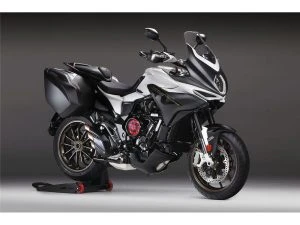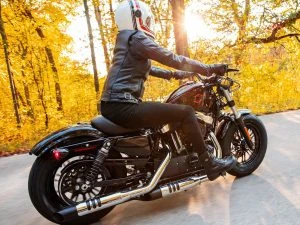Electric Vehicles (EVs)
Motorcycles

There are those of us who just don’t do motorcycles. The thought of hurtling along the motorway with a massive engine between your legs sounds downright alarming to many people, and I get that. Considering that a motorcyclist does have less protection than most road users does put a lot of people off riding a motorcycle. However, a careful and skilful rider can manage the risks and keep well out of harm’s way.
Maybe you already ride a motorbike. You might even be wondering about getting your motorcycle license. If you haven’t experienced riding a motorcycle, then the chances are you’ll enjoy the thrill of riding a motorbike safely. Safely being the important word. Once you’ve mastered the skill of riding a motorbike safely, travelling about Australia on two wheels instead of four can be a fun and exciting experience you’ll enjoy for years to come. Out in the open, taking in the sights and smells, experiencing the elements, being one with the machine as you lean through the corners and feel the response are all reasons why many people love riding motorcycles.
As a tool to combat rising fuel prices, the motorbike could be a useful option. Whether you’re single or married, the motorbike can combine with your other means of transportation to get you where you need to go. They use a lot less fuel than a car and have the size (or lack of size) that enables them to slip through congested areas and park in tight spaces. If emissions are an issue for you, then the motorbike generates less of an environmental impact than a car does.
Even with the recent global health concerns and restrictions on our daily lives, over the last couple of years the motorcycle has enjoyed an increase in sales throughout Australia. Over the 2020 period, new motorcycle and scooter sales in Australia were up 6.2% from the previous year, showing a strong demand for individual mobility transport options, of which the motorcycle is the best. And throughout 2021, the growth trend mushroomed with an increase of 16.6%. That equated to a total of 102 new units sold, the highest level for 15 years.
Honda, Yamaha, and Kawasaki claim the biggest chunks of the market share, while Suzuki, KTM, BMW, and Harley Davidson deliver strong motorbike sales. All motorcycle manufacturers have enjoyed the stronger consumer demand for motorbikes, resulting in better sales figures.
Many people find motorcycle riding a relatively easy task but riding out on the road still comes with a fair share of risk. Lack of experience and recklessness are often key areas associated with motorcycle accidents. Damp and slippery roads need to be recognized and ridden over with care.
Allowing plenty of space between you and other road users is a must, and as you ride be aware of other people’s actions, intersection dynamics, any oncoming cars, and any car (whether moving or stationary) in front of you as you ride. If you are reading the other road users well, reading the road conditions right, and keeping your distance, then motorcycling is relatively safe.
There are plenty of nice sport bikes out there like the Buell Hammerhead, Ducati V4 or the Yamaha YZF-R7. These are great bikes for a fast ride over a short distance. They can make useful commute bikes as well.

Buell Sportbike
The touring bikes and dual purpose-bikes are better set up for a comfortable seat and long distance ergonomics. These are swift bikes and can handle two-up and luggage no problems. They also make a decent commuter. Bikes like the Triumph Tiger 1200, MV Augusta Turismo, KTM 1290, Kawasaki Versys, Honda CB500X and BMW 1600 GT are great options in this class of bike. They are a heavy bike, so not ideal for learners and the inexperienced.

MV Augusta Turismo
Scooters and smaller bikes like the Honda Navi, BMW CE O4 Electric Scooter, and Honda CB300 are handy inner-city commuters and great or a learner rider.

BMW Electric Scooter
A Roadster like the Harley Davidson Street Glide ST, Harley Davidson Forty-Eight, Indian Chief, and Triumph Bonneville Bobber are all about the wow factor and looks. These are sexy bikes, but some people also find their relatively relaxed riding position, which includes arms and legs pointing forwards, nice for cruising on longer rides.

Harley Davidson Forty-Eight
An FCEV for Our Environment

With the rising concerns over greenhouse gas emissions, the development of ammonia fuelled vehicles as environmentally friendly cars would have to look rather promising. A car running on NH3 – now what’s not to like about that?
Many scientists believe that it is urgent to reduce CO2 emissions because of the global warming effect that the gas has on the climate around the globe. Despite CO2 in the atmosphere being great for plant growth (some of the edges of the earth’s deserts are greening up again with increased CO2 in the atmosphere), and the earth’s water cycle playing a pivotal role in governing the earth’s temperature, the drive to create taxing emission standards and expensive alternatives continues to drive government policy worldwide. What if we gradually changed over to another source of energy so that everyone in the world could afford the switch, allowing people to maintain a higher standard of living?
Using CO2–free fuels to reduce the level of CO2 emissions could be a viable option in the current climate. So, what about ammonia?
An internal combustion engine (ICE) burns a fuel. Basically, you can convert an engine to run on any fuel such as fossil-fuels, hydrogen and ammonia, and there are many ways to do so. ICE engines are very good in combination with battery and hybrid systems. It would be a perfect solution to make a hydrogen-fuelled vehicle with hydrogen that has been cracked out of ammonia and stored in the vehicle. The ammonia would then be used to drive the electric propulsion system because an electric propulsion system is highly efficient. That would be a perfect vehicle.
The battery system in this model would not need to be anywhere near the size of a pure EV and anywhere near the weight. For instance, in a Tesla, the whole EV platform under the car is a battery pack that is massively heavy. A clean-burning ICE producing heat-waste from the combustion process could use this heat-waste to warm up the cabin’s interior on a cold day, cool the cabin down via a heat exchanger, and could also be used to cool and heat the battery accordingly for optimum battery operating temperatures.
You can store accessible hydrogen in the form of ammonia (NH3). Unlike hydrogen gas, which requires very low (cryogenic) temperatures to liquefy, ammonia becomes a liquid at –34°C. Ammonia also does so at room temperature and at 9 atmospheric pressures, making it much more convenient to use as a transportation fuel. Ammonia is comparatively inexpensive to produce, and the hydrogen can be separated out using catalysts without undue losses.
Essentially, you have a car with a combustion engine that is burning the hydrogen that is cracked out of the stored ammonia onboard the car to produce electricity. The engine would have an alternator as an electric motor that would power the drivetrain with electricity at close to 99% efficiency. This set-up is known as a Fuel Cell Electric Vehicle (FCEV).
The FCEV above uses stored ammonia that’s cracked onboard the car to produce hydrogen to run the electric drive train – only emitting water vapour and warm air as exhaust, and is considered a zero-emission vehicle. Now that sounds pretty smart, efficient and green to me!
Australia’s Most-Loved Utes Will be Going Hybrid
Earlier this year, Toyota set the benchmark when it announced that its much-loved dual-cab ute, the HiLux would be produced in hybrid format by the end of this decade. Although a long way off, it certainly set the scene for plenty to get excited about, with electrification here and here in a big way, and only set to gain more traction as time goes on.
We’re actually somewhat optimistic that Toyota will be able to fast-track the development of a hybrid HiLux given the tailwinds in effect pushing manufacturers to accelerate the transition to more environmentally-friendly cars. So while Toyota has flagged until the end of the decade for a hybrid HiLux, that may well be the case for the company’s entire model range, rather than it’s best-seller.
Toyota has been on record as saying it believes hybrids will be one of the dominant forms of vehicle over the short-term, while also representing a major chunk of the new car market down the track.

Ford joins the party with the Ranger
Australia’s other favourite ute, the Ford Ranger, is also set for an electrified future.
The blue oval brand has confirmed it will develop a hybrid Ranger, alongside a hybrid Everest four-wheel drive, with the jointly-developed pair set to be engineered locally in Australia and assembled out of Thailand.
Pleasingly, Ford is on a fast track to production, aiming to have the duo rolled out overseas by 2024, targeting countries where emissions targets are driving the push to green vehicles. Although that date does not extend to Australia at this stage, there is likely to be pressure over the coming years, particularly on a political front, that will hasten the need for more hybrid and electrified vehicles down under.
This development could very well play into the cards of a hybrid Ranger arriving much sooner than the timeline provided by Toyota. If that looks likely, watch out, because Toyota may well throw down the gauntlet to compete with its arch-nemesis on the hybrid battlefield.
It is looking increasingly as though a hybrid Ranger will be offered in petrol-electric format, with countries across Europe and North America now seemingly putting the brakes on diesel emissions.
What’s even more interesting, however, is that the 2022 version of the Ranger has been ‘future’proofed’ to accommodate hybrid power down the track, raising eyebrows about an even earlier arrival. Ford has achieved this thanks to a redesign of the Ranger’s chassis, optimising space under the hood.
What does it all mean? The timelines might be quite distant, but we think there could very well be a surprise to the upside in terms of the hybrid development of Australia’s two best-selling cars.
What Is and Isn’t Inside an EV?
What is an EV? What are the obvious things that set an EV apart from the more conventional car that’s powered by an internal combustion engine (ICE)? And what is an EV like to maintain?
These are just a few of the good questions that might be rattling around in your mind as you consider the possibility of EV ownership. Let’s face it, most of us probably jump inside our cars and give little thought to what happens inside a car when we drive off.
Let’s start by answering the first question and develop for ourselves an understanding of what an EV is.
The letters ‘EV’ stands for the words ‘electric vehicle’. EVs don’t have a combustion engine underneath the bonnet, in fact they don’t have a combustion engine at all. This means that you won’t need to pull over at the gas station to fill your car up with any form of fossil fuel (e.g., unleaded gasoline (91), premium unleaded gasoline (95, 98 or 100 octane) or diesel. Neither will your car be running on gas (LPG or CNG). You won’t even have to top your car up with engine coolant or oil for engine lubrication. Sounds good!
Once you look away from the various processes of mining earth metals like lithium and cobalt (a by-product of nickel and copper mines); neodymium, terbium, or dysprosium (critical metals used in higher powered batteries that can last for longer distances – and everyone wants to be able to last longer) used in EV batteries and electronic componentry, EVs look to be more environmentally friendly and interesting cars to own and drive.
All your power is electronically accessible to your accelerator pedal, and your braking action is processed electronically as well. When you brake or decelerate, battery power can be reverted back into the battery pack. Basically, drain the battery in an EV, and you’ll need to plug it into a charging port again before you can get some power for driving about again. However, that’s nothing new now, is it?
To get power from your house power supply, you’ll need to have a conversion kit built into your home’s power system in order to be able to power up your EV within a suitable time frame, commonly 6 to 10 hours. More expensive options are available that will enable a quicker charging time. To get power after commuting around the city, you’re going to require a charging station or a park at work that has a convenient and vacant plug-in port for you to charge your vehicle up again to get home. There are some other charging stations (and we’ll need many more of these with more EVs running on the road) where you can park up for a couple of hours to recharge or top-up again for your commute home. If you drive your EV out of town and into the country, you’ll need to be sure that you have enough power between charging ports, because, unlike in a vehicle with a combustion engine, a jerry can won’t get you out of trouble nor will the longest power cord. I’m not sure what serious Outback off-roading enthusiasts will do if they drive an EV. Neither am I sure what mobile ‘tradies’ will do when they get caught short on power between towns.
What is missing inside an EV that you have in a common ICE vehicle?
Noise is the first thing that comes to mind. EVs do without the mechanical noise of the combustion/explosions that takes place inside a working ICE. What you do get is a very quiet ride with a bit of road noise from the tyres and wind about the bodywork as it slips through the air. Exhaust emissions are also a non-event.
EVs have no complex clutch or gearing, which means that EVs can accelerate smoothly and quickly, giving you the feeling that you’re driving a sports car. Instant maximum torque is always accessible.
A purely electric EV has fewer moving parts. There are only around about 20 moving parts in an electric motor, compared with nearly 2000 mechanical components in an ICE. The result is that an EV will need less fiddly routine maintenance jobs like changing the engine oil every 10,000km. You’ll still need to change the tyres on an EV, and you may go through more tyres because of all that instant torque and acceleration. A pricier tyre made up of a softer compound might also be necessary in order for you to be able to stick to the road better with the EV’s instant and quick acceleration.
You will also need to replace the battery pack, as they do have a life. This will be the one expensive maintenance bill. Buy a new EV, and you’ll be able to put this off for 10 years or so. Buy a second-hand EV, and who knows how long you’ll have before the battery pack will need replacing or you just won’t be going anywhere.
An EV owner will likely also need to pay some sort of road user charge or tax in the not-too-distant future, particularly if more EVs take to our roads.
However, own an EV and you won’t need an ICE tune-up or oil change, and the engine coolant won’t need to be replaced, either. In essence, an EV has no petrol, diesel or oil. It has no exhaust, no clutch or gears. It doesn’t have spark plugs, and it has no throbbing combustion noise that you find you get with a V8, a boxer or even a straight six.
As with any car, EVs have both their advantages and their disadvantages. At this stage, an affordable EV would be a great and enjoyable car for the city environment.